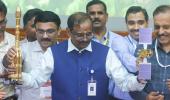The need for NavIC was cemented after India was denied access to crucial navigation data from global providers during the 1999 Kargil War.

India's independent satellite navigation system, NavIC (Navigation with Indian Constellation), will face its acid test if a war breaks out with Pakistan.
The risk of war between the two countries increased after the Pakistan sponsored terrorist attack on innocent tourists in Kashmir's Pahalgam killing 26 Indians.
Apart from the NaVIC system, India will be using its other Earth observation satellites.
The failure of the NVS-02, the second generation navigation satellite to reach its intended orbit underscores the challenges in maintaining and expanding this strategically vital system, particularly amidst heightened regional tensions.
The need for NavIC was cemented after India was denied access to crucial navigation data from global providers during the 1999 Kargil War.
This experience spurred the development of an indigenous system to ensure sovereign control over Position, Navigation, and Timing (PNT) services.

As per plans, the full constellation consists of seven satellites -- three to be in Geostationary Orbit and four in inclined Geosynchronous Orbit.
However, officials of Indian Space Research Organisation (ISRO) said four satellites can provide the required data.
Currently, NavIC provides Standard Positioning Service (SPS) for civilian use and an encrypted Restricted Service (RS) -- mainly for strategic purposes -- to the users in India and to the region extending about 1,500 km beyond the country's land mass.
However, the recent launch of NVS-02 on January 29, 2025, encountered problems.
The 2,250 kg NVS-02 satellite, designed as a second-generation replacement for the older IRNSS-1E and meant to bolster the constellation, became stuck in its Geo Transfer Orbit (GTO).
This was reportedly due to a failure of a pyro valve needed for oxidizer flow, potentially caused by an electrical connector issue.
The Indian space agency is investigating the exact cause of this failure, noted as a rare occurrence for the agency's orbital placements.

ISRO has till date launched 11 navigation satellites out of which only four are fully functional providing PNT services, while five provide messaging service, and one is completely lost.
The Indian space agency is deciding on the usage of the NVS-02 satellite.
Dr Jitendra Singh, minister of state, personnel, public grievances, pensions and Prime Minister's Office, told Parliament that a full constellation of seven NavIC satellites is expected to be completed in the coming years.
Venkatachari Jagannathan can be reached at venkatacharijagannathan@gmail.com
Feature Presentation: Ashish Narsale/Rediff.com










